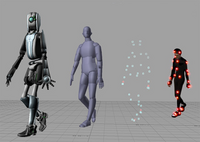
Photo from wikipedia
Realistic simulation of image formation in optical coherence tomography, based on Maxwell’s equations, has recently been demonstrated for sample volumes of practical significance. Yet, there remains a limitation whereby reducing… Click to show full abstract
Realistic simulation of image formation in optical coherence tomography, based on Maxwell’s equations, has recently been demonstrated for sample volumes of practical significance. Yet, there remains a limitation whereby reducing the size of cells used to construct a computational grid, thus allowing for a more realistic representation of scatterer microstructure, necessarily reduces the overall sample size that can be modelled. This is a significant problem since, as is well known, the microstructure of a scatterer significantly influences its scattering properties. Here we demonstrate that an optimized scatterer design can overcome this problem resulting in good agreement between simulated and experimental images for a structured phantom. This approach to OCT image simulation allows for image formation for biological tissues to be simulated with unprecedented realism.
Journal Title: Biomedical Optics Express
Year Published: 2018
Link to full text (if available)
Share on Social Media: Sign Up to like & get
recommendations!